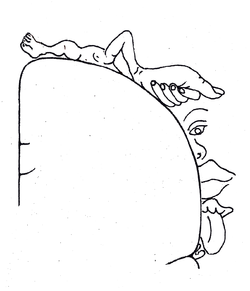
Cortical homunculus
Encyclopedia

Primary motor cortex
The primary motor cortex is a brain region that in humans is located in the posterior portion of the frontal lobe. Itworks in association with pre-motor areas to plan and execute movements. M1 contains large neurons known as Betz cells, which send long axons down the spinal cord to synapse onto...
and the primary somatosensory cortex , i.e., the portion of the human brain directly responsible for the movement and exchange of sense and motor information (namely touch: sensitivity, cold, heat, pain etc.) of the rest of the body.
There are two types of homunculus: sensory and motor. Each one shows a representation of how much of its respective cortex innervates certain body parts. The primary somesthetic cortex (sensory) pertains to the signals within the postcentral gyrus coming from the thalmus, and the primary motor cortex pertains to signals within the precentral gyrus coming from the premotor area of the frontal lobes. These are then transmitted from the gyri to the brain stem and spinal cord via corresponding sensory or motor nerves. The reason for the bizarre, distorted appearance of the homunculus is that the amount of cerebral tissue or cortex devoted to a given body region is proportional to how richly innervated and sensitive, or the number of muscles and motor units within that region is, not to its size. The homunculus is like an upside-down sensory or motor map of the contralateral side of the body. This can be seen since the upper extremities such as the facial body parts and hands are closer to the lateral sulcus than lower extremities such as the leg and toes. The decussation in the pathways also result in right gyri to receive input from the left side of the body and vica versa.
The resulting image is a grotesquely disfigured human with disproportionately huge hands, lips, and face in comparison to the rest of the body. Because of the fine motor skills and sense nerves found in these particular parts of the body they are represented as being larger on the homunculus. A part of the body with fewer sensory and/or motor connections to the brain is represented to appear smaller.
The cortical homunculus is a visual representation of the concept of "the body within the brain" that one's hand or face exists as much as a series of nerve structures or a "neuron concept" as it does a physical form. This concept relates to many neuro-biological phenomena including "phantom limb
Phantom limb
A phantom limb is the sensation that an amputated or missing limb is still attached to the body and is moving appropriately with other body parts. 2 out of 3 combat veterans report this feeling. Approximately 60 to 80% of individuals with an amputation experience phantom sensations in their...
" and "body integrity identity disorder
Body integrity identity disorder
Body Integrity Identity Disorder , formerly known as Amputee Identity Disorder, is a psychological disorder wherein sufferers feel they would be happier living as an amputee...
".
Dr. Wilder Penfield
Wilder Penfield
Wilder Graves Penfield, OM, CC, CMG, FRS was an American born Canadian neurosurgeon. During his life he was called "the greatest living Canadian"...
used a similar image to depict the body according to the areas of the motor cortex controlling it in voluntary movement. Sometimes thought to be the brain's map of the body, the motor homunculus is really a map of the proportionate association of the cortex with body members. It also reflects kinesthetic proprioception
Proprioception
Proprioception , from Latin proprius, meaning "one's own" and perception, is the sense of the relative position of neighbouring parts of the body and strength of effort being employed in movement...
, the body as felt in motion. It plays a central role in phantom limb
Phantom limb
A phantom limb is the sensation that an amputated or missing limb is still attached to the body and is moving appropriately with other body parts. 2 out of 3 combat veterans report this feeling. Approximately 60 to 80% of individuals with an amputation experience phantom sensations in their...
phenomena and their opposite such as the disappearance of body members from conscious perception with certain types of brain damage. Like the sensory homunculus, the motor homunculus looks distorted. For example the thumb which is used in thousands of complex activities appears much larger than the thigh with its relatively simple movement. The motor homunculus develops over time and differs from one person to the next. The hand in the brain of an infant is different from the hand in the brain of a concert pianist. This kind of difference is open to introspection. Most people can flex and extend the ends of their thumbs fairly easily, but relatively few can make analogous movements with any of their other fingers. The difference is due to differences in the functional organization of associated areas of the brain, which is in turn influenced by the muscular anatomy of the effector muscles of the hand.
Penfield's motor homunculus, which is usually shown as a canonical, 2D diagram is in actuality a gross oversimplification which does not show the original data Penfield collected from patients undergoing surgery for epilepsy. This simplification suggests that lesions of the motor cortex will give rise to specific deficits in specific muscles (cf. the sensory homunculus). This is not necessarily the case; lesions produce deficits in groups of synergistic muscles. This difference is critical as it suggests that the motor cortex thinks in terms of overall movements as entire libraries rather than how to move individual muscles, allowing a great deal more complexity. All in all, it is best not to assume the accuracy of Penfield's motor homunculus as it is misleading.

